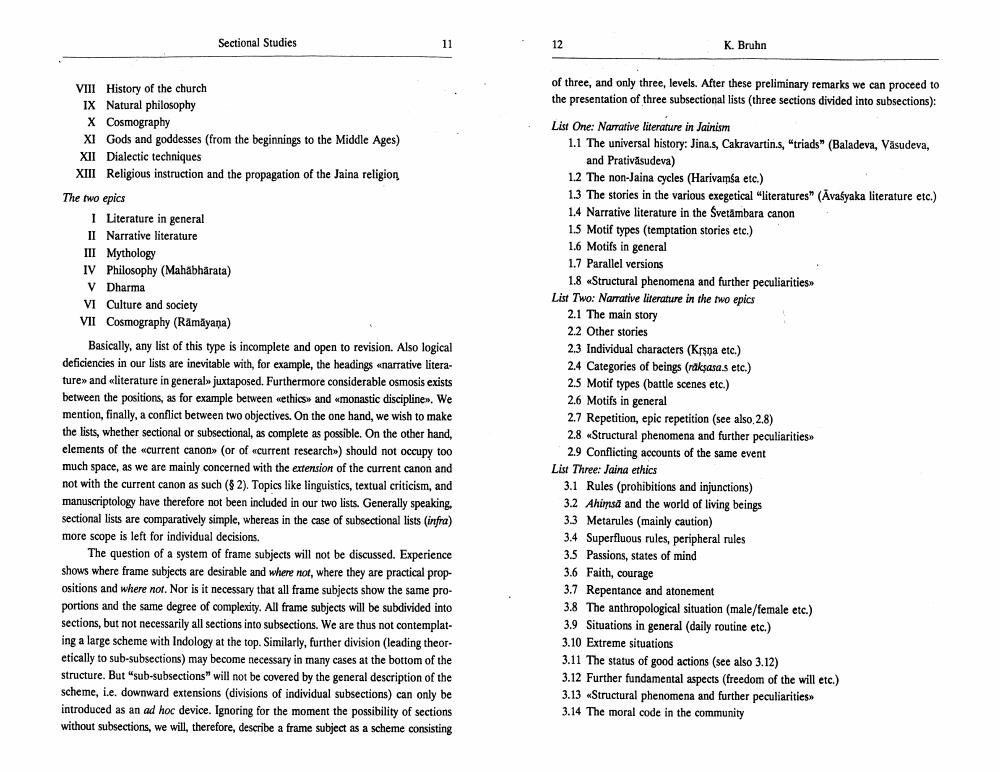Book Title: Sectional Studies In Jainology II Author(s): Klaus Bruhn Publisher: Klaus Bruhn View full book textPage 2
________________ Sectional Studies VIII History of the church IX Natural philosophy X Cosmography XI Gods and goddesses (from the beginnings to the Middle Ages) XII Dialectic techniques XIII Religious instruction and the propagation of the Jaina religion The two epics I Literature in general II Narrative literature III Mythology IV Philosophy (Mahabharata) V Dharma VI Culture and society VII Cosmography (Rāmāyaṇa) 11 Basically, any list of this type is incomplete and open to revision. Also logical deficiencies in our lists are inevitable with, for example, the headings «<narrative literature» and «<literature in general» juxtaposed. Furthermore considerable osmosis exists between the positions, as for example between «<ethics» and «monastic discipline». We mention, finally, a conflict between two objectives. On the one hand, we wish to make the lists, whether sectional or subsectional, as complete as possible. On the other hand, elements of the «current canon» (or of «current research») should not occupy too much space, as we are mainly concerned with the extension of the current canon and not with the current canon as such (§ 2). Topics like linguistics, textual criticism, and manuscriptology have therefore not been included in our two lists. Generally speaking. sectional lists are comparatively simple, whereas in the case of subsectional lists (infra) more scope is left for individual decisions. The question of a system of frame subjects will not be discussed. Experience shows where frame subjects are desirable and where not, where they are practical propositions and where not. Nor is it necessary that all frame subjects show the same proportions and the same degree of complexity. All frame subjects will be subdivided into sections, but not necessarily all sections into subsections. We are thus not contemplating a large scheme with Indology at the top. Similarly, further division (leading theoretically to sub-subsections) may become necessary in many cases at the bottom of the structure. But "sub-subsections" will not be covered by the general description of the scheme, i.e. downward extensions (divisions of individual subsections) can only be introduced as an ad hoc device. Ignoring for the moment the possibility of sections without subsections, we will, therefore, describe a frame subject as a scheme consisting 12 K. Bruhn of three, and only three, levels. After these preliminary remarks we can proceed to the presentation of three subsectional lists (three sections divided into subsections): List One: Narrative literature in Jainism 1.1 The universal history: Jina.s, Cakravartin.s, "triads" (Baladeva, Vasudeva, and Prativasudeva) 1.2 The non-Jaina cycles (Harivamsa etc.) 1.3 The stories in the various exegetical "literatures" (Avasyaka literature etc.) 1.4 Narrative literature in the Svetämbara canon 1.5 Motif types (temptation stories etc.) 1.6 Motifs in general 1.7 Parallel versions 1.8 «Structural phenomena and further peculiarities>> List Two: Narrative literature in the two epics 2.1 The main story 2.2 Other stories 2.3 Individual characters (Kṛṣṇa etc.) 2.4 Categories of beings (raksasas etc.) 2.5 Motif types (battle scenes etc.) 2.6 Motifs in general 2.7 Repetition, epic repetition (see also,2.8) 2.8 «Structural phenomena and further peculiarities>> 2.9 Conflicting accounts of the same event List Three: Jaina ethics 3.1 Rules (prohibitions and injunctions) 3.2 Ahimsa and the world of living beings 3.3 Metarules (mainly caution) 3.4 Superfluous rules, peripheral rules 3.5 Passions, states of mind 3.6 Faith, courage 3.7 Repentance and atonement 3.8 The anthropological situation (male/female etc.) 3.9 Situations in general (daily routine etc.) 3.10 Extreme situations 3.11 The status of good actions (see also 3.12) 3.12 Further fundamental aspects (freedom of the will etc.) 3.13 «Structural phenomena and further peculiarities>> 3.14 The moral code in the communityPage Navigation
1 2 3 4 5 6 7 8 9 10 11 12 13 14 15 16 17 18 19 20 21 22 ... 25
